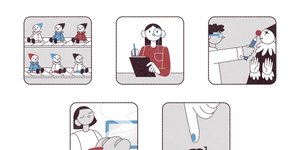✎ on writing on writing
I read a lot that was repetitive. I still felt like it was worth it. It took time to learn and absorb the material, especially the science, so reading the same thing ten times would drill that into me more. But also, that’s how you learn what is a cliche. You start to realize: Everyone says this, so I won't say it the same way.
Erika Hayasaki • Going From Idea to Published Book
when you learn about an issue and you see everyone is saying the same things about it, don’t say those things again
Tootzi instilled a philosophy of “all that exists is the artifact that’s on the table.” It doesn’t matter if your ideas come from your mind, your heart, your soul, your belly button, the tops of mountains, a bottle of red wine, or from managing an in-house spider colony (this was Salvidore Dali’s process). No matter how you arrive, conscious or... See more
Michael Dean • The Secret Architecture of Great Essays
“At a certain point, you need to take responsibility for being understood.” like an architect can’t stand outside their building handing out pamphlets explaining it, a writer can’t explain the background of their words. first draft for you, second draft for stranger.

writing a comedic list, particularly an FAQ
I suggest thinking of revision not as a single sweeping process but as a series of distinct drafts, (seven of them, cough cough ) each with a specific purpose. By focusing only on the story, or only on the characters, we avoid that overwhelming feeling of needing to fix everything at once, pinballing from clunky sentence to missing scene to... See more
Worth the Climb: Self-Editing Secrets That Actually Work
Circle every adjective and adverb in three pages of your manuscript. Challenge yourself to replace them with specific, concrete details—nouns and verbs —that show rather than tell. Instead of “she was angry,” show her “knuckles whitening around the steering wheel.”
Allison K Williams • Worth the Climb: Self-Editing Secrets That Actually Work
What is 'Memoir Plus' and why is it so hot right now? — Nour Sallam - Literary Agent
Nour Sallamnoursallam.com
The next time you do an interview, picture a box of crayons. Every detail you gather is like a crayon that you can use to fill your box. It’s unlikely you’ll use every single detail when writing your story, but if you don’t have the details to begin with, you’ll never have the option of coloring your story with them.
Mallary Tenore Tarpley • How to get better at capturing details during interviews (Part 1)
when interviewing, the details are all the crayons you can use (but don’t have to) in the story
When a writer labels a work that resembles prose as poetry, they’re suggesting the work be evaluated in the court of poetry rather than that of prose. Pay less attention to plot, narrative and other prosaic devices, and instead the building blocks of poetry: sound, rhythm, and, most importantly, image, the sensory details conjured in our minds.
KOPI BREAK ORDER #020 — Czander Tan: “Manila Skyline”
on wtf is prose poetry—and also: “If a line break truncates a thought into sizable chunks, using pauses to mediate the reading experience, this poem wants us not to pause, to quickly take in…”
your story’s “heartbeat”—the emotional core that gives your narrative life. Not the plot, but the emotional journey. For memoirists, this might be: “Learning to forgive my father taught me how to parent myself.” For novelists: “The search for external validation ultimately destroys what is most valuable.” Write a single sentence that captures what... See more